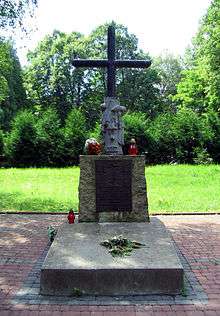Marianna Dolińska

Marianna Dolińska (1891 – 1928 in Tworki) was a Romani woman from Antoniówka, Radom County, Poland. On the night of 11 December 1923, she murdered her four children and hung them on a tree. A photograph of the bodies of the children was falsely used to represent victims of the Massacres of Poles in Volhynia and Eastern Galicia, committed by the Ukrainian Insurgent Army.
Murder of her children

In the winter of 1923, the inhabitants of Radom County in Poland were suffering from poverty and hunger. In early December, Dolińska's husband was arrested for several burglaries and his wife was left alone with four hungry children. Marianna Dolińska, who was mentally disturbed, decided that the only way to protect their children from starvation was to kill them. On December 11, 1923 she killed Zofia (6 months), Antoni (3 years), Bronisława (5 years) and Stefan (7 years) and tied them to a tree.[1] The next day she went to the police and confessed to the crime. Later Dolińska was delivered to a psychiatric hospital, where her "manic depression" and other medical disorders were identified. She died in 1928, and was buried in the cemetery of the hospital.
Publication of photographs and further events

For reasons not currently known, the image of the dead children has been repeatedly used as an illustration of the crimes allegedly committed by the Ukrainian Insurgent Army.[2]
The earliest publication of the photograph appears in the collection of Dr. Stanislaw Krzaklewski in 1993. It bears the caption "Polish children tortured and murdered by a branch of the Ukrainian Insurgent Army near the village Kozów, in the province. Ternopil, the autumn of 1943". Two years later the image appeared in the work of the J. Węgierski "Home Army in the districts Stanislaviv and Ternopil" and bears the caption "murdered by the SS-Galicia Polish children in the area Kozów".[2]
In July 2003, a monument for the Massacres of Poles in Volhynia and Eastern Galicia was created in Przemyśl, which shows the victims of Marianna Dolińska. In early October 2008, the sculpture was removed.[3]
References
- ↑ "Podobno była piękna". Wyborcza.pl (in Polish). 1980-01-01. Retrieved 2015-12-20.
- 1 2 "Fałszywy opis, prawdziwe zbrodnie". Web.archive.org (in Polish). Archived from the original on May 25, 2007. Retrieved 2015-12-20.
- ↑ "Ogołocony pomnik ofiar UPA". Nowiny24.pl (in Polish). Retrieved 2015-12-20.
